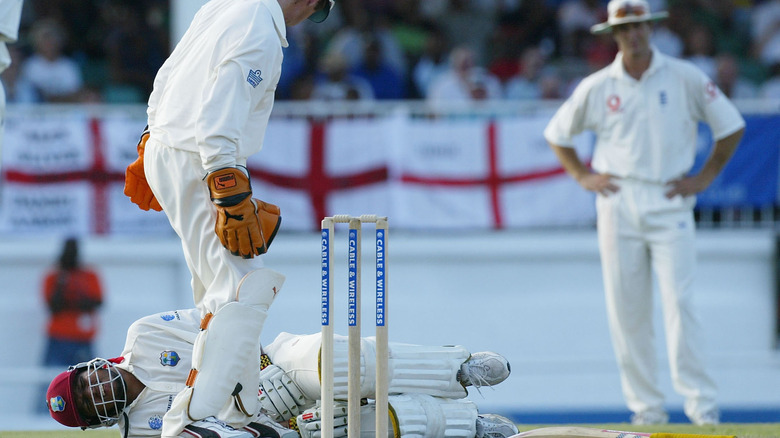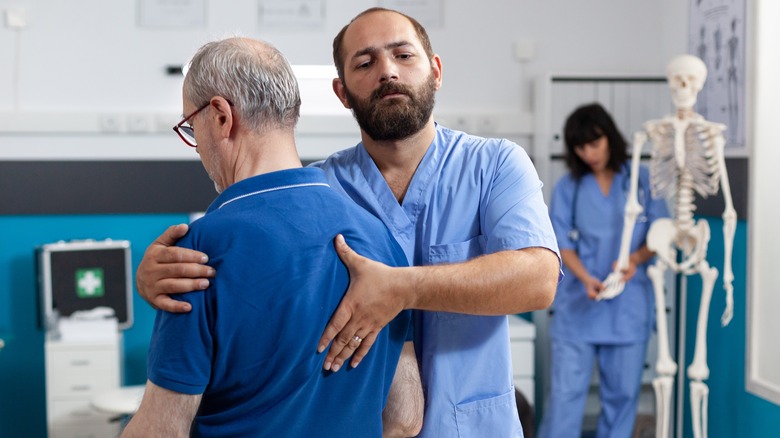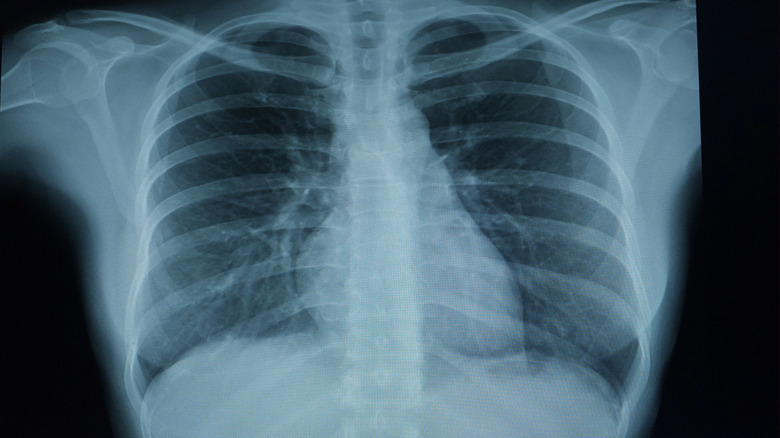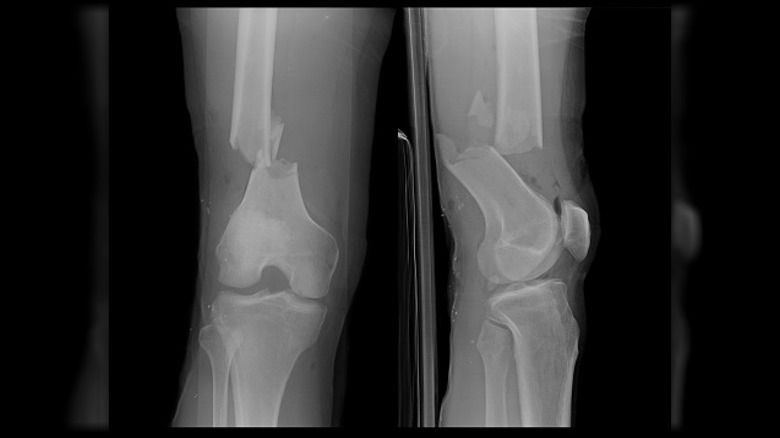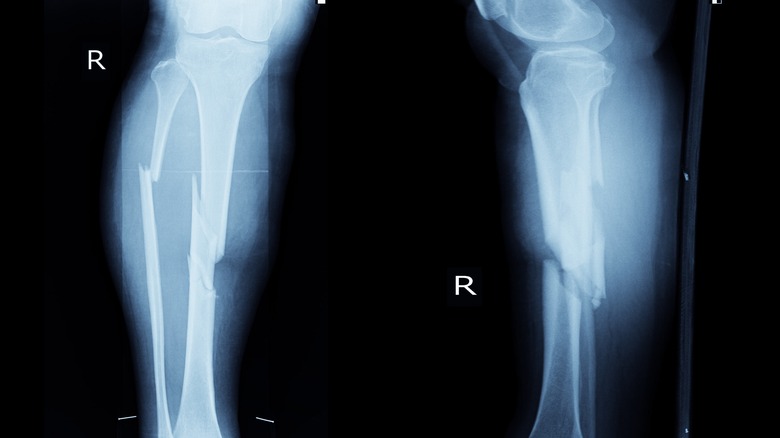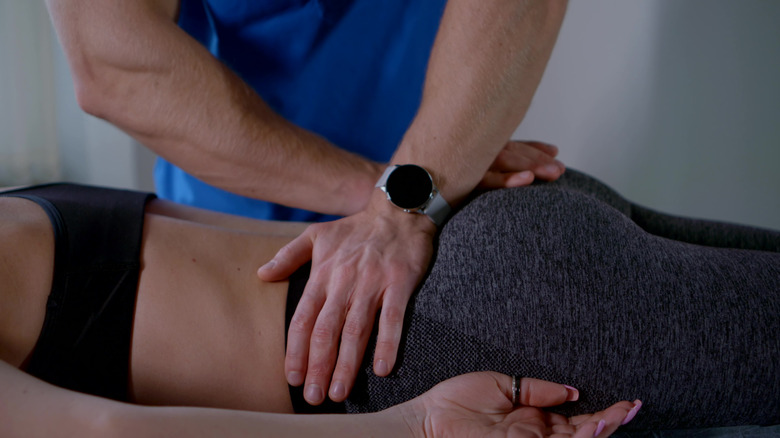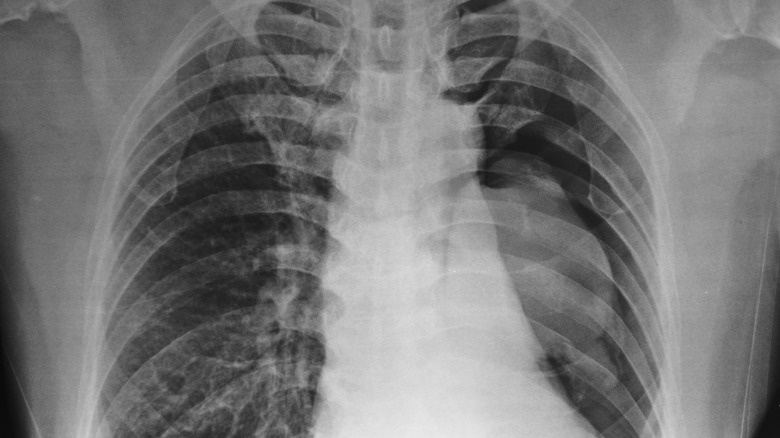The Most Painful Injuries A Person Can Get, According To Science
The human body is an amazing structure, capable of carrying us through life and its many adventures ... or even misadventures. The body can also be a walking, talking accident. And for anyone who has ever hurt themselves — whether through sports, daily activity, or simple mishap — they know that some injuries are worse than others.
If you've ever been treated for a painful injury, you may remember being asked to describe your pain. Doctors and nurses might have asked the exact location of the pain and whether it was on the surface or deeper in the tissue. They probably also asked what kind of pain you're experiencing. Is it shooting, throbbing, or dull? Maybe it feels like an extreme burning or icy sensation. Or maybe it feels like you're being stuck with pins and needles.
As they took note of your answers, they probably also asked you to describe the level of pain you are experiencing by using a pain scale or happy/sad face. Whichever scale might be used, the point is to help medical professionals determine pain levels so they can offer the right treatment, because, according to the journal Headache, everyone experiences pain differently due to different pain thresholds and pain tolerances. Still, science has gone on record which injuries regularly cause the highest levels of pain humans can experience.
Ruptured testicle
If you've ever seen a grown man doubled over on the ground trying to hold back his tears after getting a swift kick to the groin, you might think it doesn't get any worse than this. But it does. A ruptured testicle, when the membrane that contains the testicle breaks, is considerably worse. According to the Cleveland Clinic, this injury typically requires either a piercing of the scrotum or blunt force with at least 50 pounds of pressure.
In the overwhelming majority of cases, the pain is beyond excruciating. That's because genitals are densely packed with nerve endings, with researchers beginning to study just how underestimated those numbers have been (via Science Alert). On top of that, those nerves and tissues are shared with other parts of our body, which is why so many of those who suffer this unfortunate injury have a hard time pinpointing exactly where the pain is coming from — and why some even feel the pain all the way up to their stomach.
For the most part, testicular ruptures often are a sports injury (even though a 2018 study in Research and Reports in Urology found that firearms were the leading cause of testicular trauma). In December 2022, professional hockey player Blake Wheeler of the Winnipeg Jets took a puck to the groin, causing a ruptured testicle. Somehow, he kept playing and took it all in stride: "I've got three beautiful kids, we're not having any more, so what the hell," he later told reporters (via Twitter).
Eye Pain
It might just feel like a piece of dust has flown into your eye, but that seemingly inconsequential irritation has the potential to quickly become a very painful and serious injury in a matter of seconds. That piece of debris, whatever it was, can scratch the cornea — the thin, transparent dome that covers your eye's iris and pupil. In most cases, the scratch, called a corneal abrasion, is a minor injury that heals quickly. Still, the pain that comes from that scratch can be intense because of nerve density. "The cornea has among the highest densities of nerve fibers in the human body, so even a very small abrasion can be very painful," according to Dr. Jessica H. Chow of Yale Medicine Ophthalmology.
The best thing you can do in this situation is to try and flush your eye with clean water or saline. Whatever you do, don't rub your eye or touch your eyeball — that's likely to only make matters worse. If the pain continues or if you can actually see the intrusive object on your cornea, Yale Medicine stresses it's time to see a medical professional immediately. That's where you can possibly get a corneal anesthetic to reduce the immediate pain, as well as prescription eye drops to aid the healing process. If you wait too long and the eye becomes infected, it can cause a corneal ulcer, which brings with it a whole new world of pain, per StatPearls.
Rotator cuff
If you're a professional house painter, the last words you want your doctor to say to you are: rotator cuff injury. Depending on whether it's acute or chronic, dull or sharp pain, treatable by physical therapy or surgery (or both), that rotator cuff injury could become career-ending. And if that's not enough, simple tasks like reaching for a glass on your kitchen shelf can bring so much pain that you may tell yourself that it's okay to be a little dehydrated.
The rotator cuff is a group of four muscles and tendons that help support and stabilize your shoulder, making it a highly complicated and utilized body part. "The rotator cuff is the most unique and complex joint of the body, hands down," according to Dr. David Glaser, a shoulder specialist at the Penn Musculoskeletal Center (via Penn Medicine). "It has the most motion of any joint in the body."
Because of its complexity, the rotator cuff has an unusually large number of opportunities for injury. There's a wide range of pain depending on whether the tendons are slightly inflamed in the case of tendonitis, as per the Mayo Clinic, and all the way up to a severe injury where the tendons have been quite literally torn away from the bone. If you're experiencing intense or prolonged pain, medical professionals say it's important to see your doctor right away, because the next step could be losing some function in that arm (via the Mayo Clinic).
Herniated discs
In 2006, Charlize Theron learned the hard way that laughing isn't always the best medicine when she roared so hard while watching "Borat" that it sent her to the hospital with a slipped disc. "A few of us went to go and see 'Borat,' and halfway through that movie, I laughed so hard that my neck locked up," Theron later said on "Late Night with Seth Meyers" (via Insider), adding, "And, like, an ambulance had to take me to the hospital, and I was in the hospital for five days."
What's alarming about a herniated disc is how many chances it has to occur. There are 24 vertebrae in your spine, from your neck to your lower back — so that leaves a number of opportunities for something to go wrong. According to the American Academy of Orthopaedic Surgeons, all of these bones are cushioned by discs. Without those cushions, it's nothing but sharp pain from the bones rubbing together from daily activities like walking, running, and lifting.
The thing about a herniated disc is that you not only have back pain, but it can spread to other areas of the body, leading you to believe your injury is something else altogether, according to the Mayo Clinic. It doesn't matter whether you stand, sit, sleep, or walk — all of it seems to make the pain worse. Doctors warn not to just try to live with the pain, because you run the risk of doing permanent nerve damage resulting in a life filled with constant pain.
Broken ribs
Not too many of us can say we were making millions of dollars when we broke a rib, but that's what happened to Nicole Kidman not just once — but twice — when she was filming "Moulin Rouge." As Kidman told Entertainment Weekly: "I broke my rib in rehearsal. Ewan [MacGregor] is very proud to say he broke it, because we were doing a dance sequence where I'm supposed to jump in his arms, and neither of us is a trained dancer, so it was just the way he caught me." She rebroke it later in filming trying to fit into a corset.
Not only can the injury itself be painful, but just trying to breathe normally can cause extreme pain, depending on the degree and location of the injury, per Mount Sinai. To add insult to injury, a fractured rib may also be accompanied by dizziness, abdominal pain, or a cough that produces mucus or blood. And because the rib cage also supports a number of our muscles, activities that we take for granted (like picking up your child or taking out the trash) can bring sharp and immediate shooting pain that feels like you've been placed on the rack to be tortured. In each of these cases, managing your pain is paramount because it's important to breathe as normally as possible in order to avoid pneumonia, a collapsed lung, or other lung issues, per the Mayo Clinic.
Broken femur
If you remember what happened to former Kansas City Chiefs cornerback Deandre Baker in 2021, you know what this is about. After an incompletion, Baker, who was newly a Chief, sustained a grizzly injury that is hard to shake from memory. What made it so bizarre is that there was no contact, but a certain twist of the leg plus a fall was enough to fracture his femur. As Dr. Brian Sutterer, a physiatrist affiliated with the Mayo Clinic who frequently breaks down football injuries, put it on his YouTube channel, "Deandre Baker broke his femur, the strongest bone in the human body, on what has to be one of the most shocking and truly rare injuries in NFL history."
The femur is your thigh bone and both the longest and strongest. Because of those qualities, it takes an extraordinary amount of pressure to cause it to break. According to the Cleveland Clinic, car accidents are the most common cause, but elderly people who are prone to falling are also at high risk due to weaker bones. If you do manage to break your femur, there's no avoiding immediate and severe pain, thanks to broken, jagged bone tearing into muscle and skin. Treatment is typically surgery, often traction, and significant physical therapy — all of which could take as much as six months to heal (but the process of bone formation could take years).
Broken tibia and fibula
It's pretty much impossible to talk about broken legs and football without mentioning the granddaddy of them all. It was November 18, 1985, and Washington was engaged in a Monday night football battle with the New York Giants with a march toward the playoffs in sight. And then it happened. Giants linebacker Lawrence Taylor sacked Washington quarterback Joe Theismann with such force that the two major bones below his right knee — the tibia and the fibula — snapped so hard that one jabbed through his skin. "All of a sudden, I heard, out to the left, it sounded like two muzzled gunshots," Theismann later told Washingtonian.
The tibia is the shinbone, and the larger of the two bones in the lower leg, per Boston Medical. And if you've broken the tibia, chances are the smaler fibula is broken, as well. The pain is immediate, and it's severe thanks to the two bones ripping through your flesh. "I've been asked many times, did it hurt? It absolutely did hurt. The pain was excruciating — both bones were shattered," Theismann said. But he also noted that he was thankful for how quickly the body reacts to protect itself, adding, "[I]t gave me an appreciation for just how great the human body is, because by the time the trainers and the doctors got to me, I had no feeling from the knee down. My leg was completely numb."
Broken tailbone
If you've cracked or broken your tailbone, there's nothing but bad news for a while. That's because almost everything you do can irritate it: standing, sitting, laying down, and even being on the toilet too long. The tailbone, also known as the coccyx, is a group of small bones at the end of your spine composed of three to five vertebrae, as per The Human Bone Manual. When a doctor is checking to see if you've broken your tailbone, they'll first feel around the injured area to determine how much pain you're in. Then, according to St. Luke's, comes the uncomfortable part: a rectal exam where they grasp the tailbone from the inside. Finally, they may order an x-ray.
Unfortunately, the road to recovery can take a long time, because there's no way to keep a fractured tailbone in place in the same way a broken arm would have a cast. And if that's not enough, women are more likely to injure their tailbones than men because of the possibility of fracture during childbirth (via The Ochsner Journal). On the upside, treatment is much less invasive, focusing on comfort while the injury heals. That amounts to lots of icing and that embarrassing donut seat cushion. Doctors warn that it's important to take the treatment seriously and be diligent about it — even if it feels like there's been no improvements — because if it worsens, surgery could be necessary.
A ruptured achilles tendon
It's the sports injury almost every athletic person is frightened of experiencing — a ruptured Achilles tendon. And it's no wonder. The overwhelming majority of cases are experienced by those who frequently engage in sports or athletic recreational activities. According to a 2018 article in the Orthopaedic Journal of Sports Medicine, more than 80% of Achilles tendon ruptures occur in people who regularly participate in sports or physically demanding hobbies. Those who play basketball were the largest group at 43%, while those who engage in football, soccer, tennis, running, and hiking were also at risk.
There's no mistaking what's happened when you've ruptured your Achilles tendon. As the body's largest tendon (via the American Academy of Orthopaedic Surgeons), you hear a loud pop. That's the first symptom. But before you even finish the question "What was that sound?" you're dealing with an excruciating level of sharp pain at the back of your ankle, which is likely shooting up your calf and down to your heel, according to the Mayo Clinic. That pain will likely only get worse if you try to walk on it, and you may even feel the gap where the tendon was once whole. Surgery isn't always necessary, but it is common among younger patients and serious athletes. Rehab is absolutely necessary for a ruptured Achilles tendon, and most people return to their previous performance level in less than six months.
A collapsed lung
A collapsed lung can easily cause justifiable panic. You might experience rapid breathing that all of a sudden becomes shallow, seemingly unable to catch your breath. According to Penn Medicine, your heart rate rapidly rises at the same time your blood pressure feels like it's plummeting. And if you look in the mirror, you might notice your jugular vein has enlarged (via the Cleveland Clinic), and your skin might be turning blue due to a lack of oxygen. On top of all those alarming symptoms, you will likely feel a sharp, stabbing pain in your chest that might feel like it will never go away.
A collapsed lung, also known as pneumothorax, occurs when air leaks from the lung. But it doesn't escape the body. Instead, it's trapped in the chest cavity and puts pressure on the lung, which then causes it to collapse. Per the Cleveland Clinic, the cause of the collapsed lung — like a car accident or a stab wound — may be the most immediately painful event. However, bodily trauma isn't always necessarily required for a collapsed lung, and the effects of not being able to breathe properly can bring waves of pain to other parts of the body. In many cases, rest and supplemental oxygen are the treatment for a collapsed lung, but other avenues could include removing the escaped air through a medical procedure.

